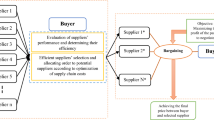Abstract
In an inter-firm make-to-order production environment, it is not always possible to satisfy the available-to-promise (ATP) and capable-to-promise (CTP) conditions due to untimely and unmatched production capacity and customer demand. Therefore, it is important to quickly explore alternate solutions that would satisfy both the customers and the suppliers. The purpose of this paper is to present a multi-agent-based system for automated multi-attribute negotiation in order promising. Our proposed solution is based on concepts of evolutionary system design that advocates for continued exploration of new solutions until a satisfactory solution is found. Based on a number of real-life ordering situations—changes of delivery date, price adjustments, and addition/modifications of value-added services as part of the order package, we embed multi-attribute multi-utility simulations into a linear program to search for a negotiated solution when a typical ATP/CTP function of a supply chain management system fails to fulfill a customer order.














Similar content being viewed by others
References
Agatz NAH, Fleischmann M, van Nunen JAEE (2008) E-fulfillment and multi-channel distribution—a review. Eur J Oper Res 187:339–356
Azevedo AL, Sousa JP (2000) A component-based approach to support order planning in a distributed manufacturing enterprise. J Mater Process Technol 107:431–438
Ball MO, Chen C-Y, Zhao Z-Y (2004) Available to Promise. In: Simchi-Levi D, Wu D, Shen M (eds) Handbook of quantitative supply chain analysis: modeling in the E-business era. Kluwer, Boston, pp 447–484
Bichler M, Kersten G, Strecker S (2003) Towards a structured design of electronic negotiations. Group Decis Negotiat 12:311–335
Bixby A, Downs B, Self M (2006) A scheduling and capable-to-promise application for Swift and company. Interfaces 36(1):69–86
Bui T (1987) Co-oP: a multiple-criteria group decision support system. Springer, NewYork
Bui T, Bodard F, Ma PC (1998) ARBAS: an action-resource based argumentation systems. J Manag Inf Syst 14(3):223–237
Bui T, Gachet A, Sebastian H-J (2006) Web services for negotiation and bargaining in electronic markets: design requirements, proof-of-concepts, and potential applications to e-procurement. Group Decis Negotiat 15:469–490
Bui T, Lee J (1999) An agent-based framework for building decision support systems. Decis Support Syst 25:225–237
Bui TX, Shakun MF (1996) Negotiation processes, evolutionary systems design and NEGOTIATOR. Group Decis Negotiat 5(4–6):339–353
Bui T, Bosse T, Hempsch C, Sebastian H-J (2009) A multi-agent simulation framework for automated negotiation in order promising. In: Proceedings of AMCIS conference, San Francisco, August 2009
Bui T, Sebastian H-J (2010) Integration of multi-criteria decision analysis and negotiation in order promising. In: Proceedings of the 43rd HICCS conference, Kauai, January 2010
Chen C-Y, Zhao Z-Y, Ball MO (2001) Quantity and due date quoting available to promise. Inform Syst Front 3(4):477–488
Cohen M, Lee H (1988) Strategic analysis of integrated production-distribution systems: models and methods. Oper Res 36(2):216–228
Conklin J, Begeman M (1988) gBIS: a hypertext tool for exploratory policy discussion. ACM Trans Inform Syst 6(4):303–331
Dudek G, Stadler H (2005) Negotiation-based collaborative planning between supply chain partners. Eur J Oper Res 163:668–687
Emerson D, Piramuthu S (2002) Agent-based framework for dynamic supply chain configuration. In: Proceedings of the 37th Hawaii international conference on system sciences, IEEE, 0-7695-2056-1/04
Fischer ME (2001) Available-to-promise: Aufgaben und Verfahren im Rahmen Des supply chain managament. S. Roderer Verlag, Regensburg
Frey D, Stockheim T, Woelk P-O, Zimmermann R (2003) Integrated multi-agent-based supply chain management. In: Proceedings of the twelfth IEEE international workshop on enabling technologies: infrastructure for collaborative enterprises
Fulkerson B (1997) A response to dynamic change in the marketplace. Decis Support Syst 21:199–214
Fung RYK, Chen T (2005) A multiagent supply chain planning and coordination architecture. Int J Adv Manuf Technol 25:811–819
Gallien J, Tallec YL, Schoenmeyr T (2004) A model for make-to-order revenue management, Working Paper
GNU Linear Programming Kit, Version 4. http://www.gnu.org/software/glpk/
Grieger M (2003) Electronic marketplaces: a literature review and a call for supply chain management research. Eur J Oper Res 144:280–294
Interface, GLPK 4.8 J.: http://bjoern.dapnet.de/glpk/
Jennings NR, Sycara K, Wooldridge M (1998) A roadmap of agent research and development. Int J Auton Agents Multi-Agent Syst 1(1):7–38
Julka N, Srinivasan R, Karimi I (2002) Agent-based supply chain management-1: framework. Comput Chem Eng 26(12):1755–1769 (15)
Karacapilidis N, Papdias D (1999) Computer-supported argumentation and collaborative decision-making: the HERMES system. Inform Syst 26(4):259–277
Kellett PM (2007) Conflict dialogue: working with layers of meaning for productive relationships. Sage, New York
Kilger C, Schneeweiss L (2005) Demand fulfillment and ATP. In: Stadtler H, Kilger C (eds) Supply chain management and advanced planning, 3rd edn. Springer, New York, pp 179–195
Kilger C, Meyr H (2008) Supply chain management and advanced planning, 4th edn. Springer, New York
Larsson S (2002) Issue-based dialogue management. Working paper, Department of Linguistics, Goteborg University, Sweden
Louta M, Roussaki I, Pechlivanos L (2008) An intelligent agent negotiation strategy in the electronic marketplace environment. Eur J Oper Res 187:1327–1345
Makatsoris C, Chang YS (2008) Beyond CRM: a system to bridge the gap between the customer and the global manufacturing supply chain. In: Proceedings of the 41st Hawaii international conference on system sciences
Meyr H (2004) Supply chain planning in the german automotive industry. OR Spectrum 26:447–470
Moodie DR, Bobrowski PM (1999) Due date demand management: negotiating the trade-off between price and delivery. Int J Prod Res 37(5):997–1021
Moses S, Grant H, Gruenwald L, Pulat S (2004) Real-time due-date promising by build-to-order environments. Int J Prod Res 42(20):4253–4375
North M, Howe NCT, Howe HT, Vos R The Repast simphony runtime system. http://repast.sourceforge.net/
Olhager J, Ostlund B (1990) An integrated push-pull manufacturing strategy. Eur J Oper Res 45(2–3):135–142
Richards HD, Dudenhausen HM, Makatsoris C, de Ridder L (1997) Flow of orders through a virtual enterprise—their proactive planning and scheduling, and reactive control, Comput Control Eng J 173–179
Rupp T, Ristic M (2004) Determination and exchange of supply information for co-operation in complex production networks. Robot Auton Syst 49:181–191
Sadeh N, Hildum D, Kjenstad D (2003) Agent-based E-supply chain decision support. J Org Comput Electr Commer 13(3):225–241
Shin K, Leem CS (2002) A reference system for internet based inter-enterprise electronic commerce. J Syst Softw 60:195–209
Stadtler H (2005) Supply chain management and advanced planning—basics, overview and challenges. Eur J Oper Res 163:575–588
Tan GW, Shaw MJ, Fulkerson B (2000) Web-based supply chain management. Inform Syst Front 2(1):41–55
Vidal CJ, Goetschalckx M (1997) Strategic production-distribution models: a critical review with emphasis on global supply chain models. Eur J Oper Res 98:1–18
Wu H–H, Liu J-Y (2008) A capacity available-to-promise model for drum-buffer-rope systems. Int J Prod Res 46(8):2255–2274
Yan Y, Yen J, Bui T (2002) A multi-agent-based negotiation support system for distributed transmission cost allocation. Int J Intell Syst Acc Financ Manag 10(3):187–200
Zhang X, Ou J, Gilbert SM (2008) Coordination of stocking decisions in an assemble-to-order environment. Eur J Oper Res 189:540–558
Zhao Z, Ball MO, Kotake M (2005) Optimization-based available-to-promise with multi-stage resource availability. Ann Oper Res 135:65–85
Acknowledgments
This research is supported by the DAAD (German Academic Exchange Service) through the PPP-program.
Author information
Authors and Affiliations
Corresponding author
Rights and permissions
About this article
Cite this article
Hempsch, C., Sebastian, HJ. & Bui, T. Solving the order promising impasse using multi-criteria decision analysis and negotiation. Logist. Res. 6, 25–41 (2013). https://doi.org/10.1007/s12159-012-0094-9
Received:
Accepted:
Published:
Issue Date:
DOI: https://doi.org/10.1007/s12159-012-0094-9




